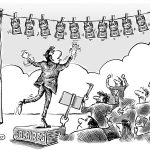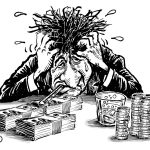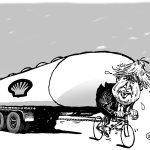It’s time to look beyond Covid-19
After several weeks of confinement, the conditions and the organization of the return to normal activities remain to be specified and will not be without risk.
When will I see my hairdresser again? This futile exclamation yet illustrates, in many ways, the time of deprivation of movement and the impact of the pandemic on ordinary economic life. After a month of effective confinement, more or less strict, if we have not been affected by the disease and our loved ones are safe and sound, impatience wins, feverishness too.
The daily announcements of the number of victims must encourage us to remain confined and aware of the need to contain the advance of the pandemic, with the means at our disposal, pending remedies and vaccines. We owe ourselves to this discipline, as we owe it to all those who fight at the front to heal and preserve us.
But it is also up to the “rear” to think about the aftermath and the end of confinement. This situation is not sustainable on a human or economic level. We see its devastating effects every day, on the most fragile, the most destitute and the most exposed. The media are now reporting the growing number of tragedies taking place behind closed doors. And initial statistical estimates give an idea of the magnitude of the looming recession.
The set of economic measures remains in the set calibrated for 6 to 8 weeks of stopping at most.
The world is also putting itself in order and it is reassuring. This period of confinement is neither a period of abandonment nor of inaction. After the emergency, the present is used to prepare for the future. First and foremost in terms of care capacity, and beyond, prevention. Exceptional endowment funds, widening of sickness benefits, care of people at risk, transportation of materials and organization of prevention, are now the priority. Then come the precautionary measures concerning businesses and households. But all of the economic measures, as massive as they are – and they are – remain on the whole calibrated for 6 to 8 weeks of suspension of activity at most. In view of the vertiginous increase in unemployment, this is easily understood.
In these conditions, we will have to organize ourselves to resume our activities, in a health environment that has become risky. The difficulty lies in the fact that the more severe the confinement, the fewer people will be immunized. Thus in France, the Scientific Council estimates that only 10% to 15% of the population would have been naturally immunized.
Several European countries are already announcing dates for gradual resumption of activity, starting with schools, shops, crafts, the self-employed and the liberal professions. Teleworking is likely to last, the question of reopening borders within the single market seems delicate. It is nonetheless vital for the movement of goods. Overall, the economic scenarios that we are observing, implicitly expect a return to normal for the start of the September school year, and a rebound for the end of 2020. It is on this condition that the catching up of the activity, if not total, at least sufficiently marked, will have preserved production and consumption capacities, and limited the increase in the number of unemployed.
The scenarios are marred by many hazards. The most important is a second pandemic wave in the Autumn, after deconfinement.
These scenarios are marred by many hazards. The most important of course is the risk of a second pandemic wave in the Autumn after deconfinement. The behavior of households and businesses is also subject to questioning. Measures to preserve purchasing power, closings of shops, should lead to a savings surplus, which households could use to consume. But will they be willing to do so? Will companies be able to resume their investment programs, or in some cases even accelerate them, when the crisis has severely reduced margins? Finally, sectors such as construction, tourism, aviation, are under the threat of a more lasting fall in their activity.
Beyond that, as we already know, the desire to better control the chains of subcontractors should accelerate the movement to reorganize world trade, while many companies will reconsider their industrial dependence on China. Will these reconfigurations and other economic and monetary measures ultimately reduce inflation? We will explore this issue in another paper.
In any case, initiatives and solutions are emerging everywhere that will enable us to face this new situation. From scientific cooperation to organizing the production and transport of essential goods, initiatives are popping up everywhere. Discipline, agility, and coordination will be the watchwords of this second phase more than ever.
First published in French, in Allnews.ch April 14 2020
Copyright Barret



